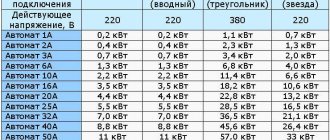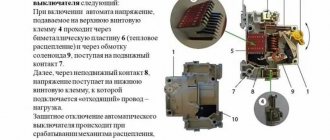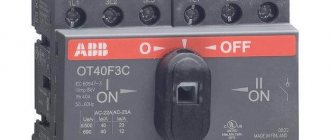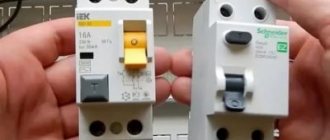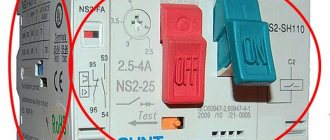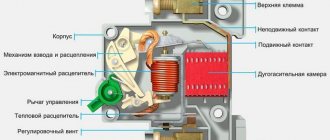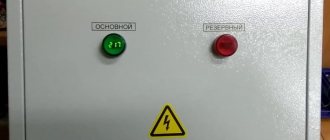Automatic switch between main and backup lines
This device is needed to automatically switch the load between the main (priority) and backup power lines. If it’s really on your fingers, then so that if there is a power outage in a country house, you can start the generator and continue surfing the Internet until the power failure is eliminated. Result: you can take several photos under the cut with a total volume of about 4-5 megabytes
If it’s really on your fingers, then so that if there is a power outage in a country house, you can start the generator and continue surfing the Internet until the power failure is eliminated. Result: you can take several photos under the cut with a total volume of about 4-5 megabytes
I wanted to write another fascinating review about the power bank, or about the B6 charger, or about the piston from Xiaomi, but that’s in the future. For now, read a boring review about a thing with a motor - Carlson automatic switch
Although this is a necessary thing, it is quite rarely used in everyday life, so I will try to adhere to the basic principle: “brevity - p. T."
So. In case of a power outage, the country house has a gasoline generator. There is a special switch in the panel that connects the house either to electricity from the poles or to electricity from the generator. Previously, I used a reversing switch from the well-known company ABB, but this thing is difficult to switch and quite expensive (currently a switch for 63A current costs $100-120).
A little less than a year ago, 2/3 of the house burned down, so now they have rebuilt it, and again we have to solve the issue of switching between the main line and the generator. I decided to save money and buy a similar device for pennies from the Chinese upd. Let me explain separately - the house burned down due to a burnt-out pipe in the bathhouse, and not because of the electrics. And the words about kopecks should be interpreted in such a way that $120 for a simple manual switch, which does not even have a shabby resistor, is, in my opinion, overkill. Its price is $15 on market day, which is what it was calculated on.
In the process of searching, I came across an automatic switch for $16.56, and after a week of deliberation, it was decided to try playing Chinese roulette, since there were no reviews for this thing or any other information, and I didn’t really look for it
There was no free shipping, the cheapest paid shipping was through SPSR, costing $17.25. The Toad, of course, protested, but the total $33.81 is still less than the $100 looming on the horizon, so he showed willpower and clicked the “Buy from this seller” button.
As a result, a week of waiting before sending, then another 12 days of traveling around the continent, and in the end the treasured box lies in a parcel locker 3 minutes from home. For those who haven’t encountered it yet, a parcel locker (post office) is a thing made up of many cells for quickly receiving mail. You enter the secret code from SMS into the terminal, a cell with your product opens, you take it and rejoice
Packed as standard: a little bubble wrap, a cardboard box, inside a plastic bag the switch itself
The fact that they charge money for delivery does not mean that it will be treated with any more care. Apparently mine was dropped. The metal, about 1 mm thick, was bent, at least they didn’t drop it with the plastic down, it would probably have cracked
The first thing that catches your eye is its fairly large weight and dimensions. Height 12 cm, width 15 cm, depth 13 cm. Weight about one and a half kilograms. Thus, in width this module will take up as much as 7.5 DIN space. However, this is not much more than ABB
The kit includes two bolts for fastening the handle and two stickers for it. For what? Apparently, it’s not a pity. Plus the standard “beggar” about “five-star positie feedback” (in the end I gave it 4 stars, but more on that below)
The second is a body with large gaps. The plastic itself is ordinary, does not smell, and is quite thick. But it is attached to the metal base with weak clips, which is why the gaps between the lid and the base reach 1 mm.
All you have to do is squeeze the two halves together and the gaps disappear
Bottom view
Well, okay, gaps are not a big deal. In the end, it will stand in the shield, where there is especially no need to look. Let's take off our “clothes” in anticipation of technoporn
Well, not porn, of course, but techno. The simplest device is two packets, two limit switches and a reversible motor. A controversial design, in my opinion, but remembering $16.5, I understand that this is nitpicking
There are 4 LEDs on the front side of the device. The LED lights up if there is voltage on the corresponding contacts nearby. This way you can monitor the status of the main and backup lines. These LEDs can also be duplicated on the front side of the shield by connecting indicator lamps to the green connector
Everything looks quite neat, the inner perfectionist is not particularly indignant
But the soldering was a little disappointing. Uncle Liao minorly sabotaged his monotonous job of soldering LEDs
One LED is poorly soldered, the solder has fallen off, the leg is dangling, but it’s not very visible in the photo
The second LED is more sad: they forgot to bite off its leads and hung the noble snot with solder
Okay, a soldering iron and wire cutters are at hand, it can be removed in half a minute. We inspect the rest of the electronics, there seem to be no problems
Can be connected to electricity. The switch works. Moreover, it is quite fast (switching time is around 1 second) and quiet, I expected more noise from such a motor. If you switch the red switch to manual switching mode, the handle turns quite hard, but easier than in the ABB switch mentioned above
To summarize: it’s a completely normal device, I think there will be no problems with it in operation, there’s nothing to break. I recommend, but with a visual inspection before commissioning. On the eve of 11.11, sold raised the price by one and a half bucks, but participates in the promotion with a price of $16.50 upd. In the comments they recommend replacing Chinese machines with Russian analogues in order to eliminate a potentially weak link, who knows how they are built inside (I will then change and add a disassembled machine to the review)
I recommend, but with a visual inspection before commissioning. On the eve of 11.11, sold raised the price by one and a half bucks, but participates in the promotion with a price of $16.50 upd. In the comments they recommend replacing Chinese machines with Russian analogues in order to eliminate a potentially weak link, who knows how they are built inside (I will then change and add a disassembled machine to the review)
I forgot to mention one nuance. It's obvious, but still. This thing only switches lines, but does not turn on the generator. Therefore, when the power goes out, all you have to do is go and start the generator (it starts with a button). As soon as there is voltage on the backup line, the automatic transfer switch will transfer the house to power from the generator. If there is power at this time, the switch will switch the house back to it, the generator will need to go and turn off
Automation of this part, although possible, is not relevant, since power outages are mainly associated only with accidents in the city network, which are quite rare and can be eliminated quite quickly
Thank you for your attention. Ask questions, criticize, praise. First post after all
upd. Posted a video, thanks madeweb
! Extraneous sounds can be heard in the video - the wife is doing needlework, sewing on a typewriter. Don't be scared 
upd2. Although there are circuit breakers here (D63A), the steering knuckle will not allow them to operate in case of current overload. When you turn on the machine, the fist supports it from below, and since the motor itself is very tight, no clicking will occur, the machine will remain in the on state. Keep this in mind.
upd3. I was corrected that the circuit breaker should work even when the lever is clamped, so if the circuit breaker is not crooked, the addition of upd2 does not matter
Principle of operation
Regardless of how the ATS module is made, the basis of the unit’s operation is monitoring network parameters. For this purpose, a voltage monitoring relay with microprocessor control units is used. The principle of operation is as follows: voltage is supplied to the center of the indicator lamp and relay. Next, the contacts change their position and current is supplied to the working line.
If the operating line current is lost, the lamp goes out and the relay stops working. The contacts are swapped again. This causes the backup power to turn on. As soon as the voltage is restored, the relay comes into action and re-switches the current to the working line.
Note! The presented scheme of work is simplified. To better understand the processes occurring in the equipment, it is not recommended to use it as a basis
A simple circuit of a single-phase ATS
Purpose of AVR
The purpose of this system in electrical engineering is similar to the organization of uninterruptible power supply. The main task of automatically introducing backup power is to quickly restore power supply without human participation in this process. At large substations there are always two inputs into two sections of the switchgear, separated by a sectional switch, operating autonomously from each other. According to the PUE (electrical installation rules), automatic connection of backup power and supply to 2 inputs is a mandatory measure for providing electricity to consumers of the first category.
A simple example of the need for this system can be given regarding the lighting of some important protected area. That is, when the main input is disconnected, the system itself will turn on the power from the backup source, while this important area will remain brightened
The maximum that can occur is a short-term cessation of nutrition, which is even difficult to visually track. This depends on the speed of operation of the ATS; the time for switching on the reserve should be about 0.3–0.8 seconds.
Description of the device
Automatic transfer of reserve is a system that is needed to provide power supply loads with a reserve charge. It is carried out in two versions. It can be one-sided or two-sided. In the first there is a division into a working and a reserve section, but in the second there is no such thing. In the first case, you can switch to normal mode or emergency mode; in the second case, these modes are not necessary.
Safe operation of electrical equipment as one of the purposes of the device
The main purpose of the module is to make the power supply system more reliable. This device quickly connects loads to the backup input type when power outages occur. To ensure automatic switching, the system monitors voltage and current at all times. This is its purpose.
Explanation of the abbreviation AVR
The abbreviation is deciphered very simply. ATS is an automatic transfer of reserve. Sometimes switching is used instead of the word input, but this is incorrect, because by input is meant generator start-up as a backup source.
How does the abbreviation stand for?
Classification
Depending on the design of the AVR unit, the equipment is classified according to the number of sections, type of network, voltage class, power and response time.
Note! ATS is often available with one, two and three outputs to ensure high network reliability. Also available in single-phase, two-phase and three-phase
According to the voltage class, it handles up to 1000 volts.
AVR cabinet for three inputs
Primary requirements
When purchasing and installing on a network, users are required to have the ATS:
- ensured the supply of energy in the event of an unforeseen interruption in line operation;
- restored electrical power as quickly as possible;
- necessarily acted once, that is, there should not be several modes of operation at once;
- turned on the main power before the backup electrical power was supplied.
In addition, it must monitor the health of the equipment control circuit.
Fast restoration of electrical power is the main requirement for the system



